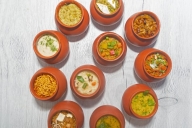Mumbai (IANS) Guess what dish turns on Jitendra Shah, a Mumbai-based tour operator-turned-restaurateur? Something that turns off most people — the humble and dismissively prepared ‘Khichdi’.
This backbencher dish has been an all-time favourite of Shah, who has been relishing the concoction prepared by his mother and grandmothers (both maternal/paternal) for years.
However, it was only at the age of 60 that he could muster the courage to bring ‘Khichdi’ to the forefront of Mumbaikars’ palates, offering them delicious plates of the simple preparation as haute-cuisine in the luring ambience of his four restaurants, “Khichdi – The Global Food”.
“I still remember how my mother and grandmothers used to casually prepare ‘khichdi’, as a quick snack or a full meal, when the kids were ill, and occasionally for the school tiffin. Sometimes, they whipped up a ‘khichdi’ as main course for lunch/dinner for the entire family when they secretly desired ‘an off’ from the cumbersome kitchen chores,” Shah told IANS with a chuckle.
The ‘khichdi’ came with a variety of aromatic home-made spices, with rice and one or more ‘dals’ (pulses), served with a large dollop of pure cow-ghee as an icing on the bubbly hot delight, mostly as an independent dish, but occasionally accompanied by ‘curd curry’, ‘liquid dal’, buttermilk, or lassi to wash it down smoothly.
“Indeed, those were hearty meals, all family members relished it till their tummies were full, but nobody ever fell ill, and our original ‘Kitchen Queens’ also enjoyed a sort of ‘weekly off’, thanks to the ‘khichdi’ celebration,” Shah recalled.
Having left his native Jamnagar (Gujarat) to become a domestic and global tour operator in 1987, Shah roamed around the world with his “Heena Tours”, but often suffered from ‘khichdi pangs’, especially abroad where the culinary options were limited.
“As the tour numbers soared, the Indian tourists demanded ‘home-style food’ in alien lands. I started taking Indian cooks, who made it a point to serve at least 50 per cent of all meals as ‘khicdhi’ in different varieties. My patrons would go wild with joy, enjoying piping hot ‘khichdi’ in the bone-chilling cold of Russia, the snowy Alps of Switzerland, near the Niagara Falls in USA and Canada, cold rains in Australia, cool climes of Europe, China, et al,” he said.
At his outlets in Mumbai’s Vile Parle, Mulund, Ghatkopar and Borivali (from next week), Shah started with a manageable 25 ‘khichdi’ varieties, which were lapped up by the hungry patrons faster than they were cooked in huge earthen pots.
Now, it has gone upto 111 ‘khichdi’ varieties and with further research, he promises to offer a whopping 250-strong ‘all-khichdi’ menu, covering all states, regions, community specialities, etc.
“Khichdi finds reference in our ancient texts, during the Mohenjo Daro era of the Indus Valley Civilisation nearly 4,500 years ago. Unfortunately, its significance has dimmed only in the past five decades with the advent of so-called ‘fast foods’. Through my restaurants, I have tried to revive it and people have endorsed it,” he said modestly.
“If Café Coffee Day, McDonalds, Starbucks and Pizza outlets can lure people with their limited offerings, ‘Khichdi’ stands an even better chance, for its high nutritional value, health benefits and historical linkage. It’s a culturally unifying dish,” said Shah.
Before launching the first outlet in mid-2018 without fanfare, for six months Shah conducted a thorough research on ‘khichdi’ prepared all over India, then took great pains to source the local spices, the huge earthen vessels made with the right kind of earth for the cooking.
“Then, the bigger challenge was – training my bewildered retinue of professional chefs on how to ‘cook’ the most common dish of Indian kitchens! They had heard of and even tasted ‘khichdi’ at home, but never prepared it professionally in huge quantities for restaurants,” he laughed.
Group CEO Tina Joshi said hungry patrons at the restaurants daily await their turn, but weekends in particular witness a rush of customers all thronging to gulp their preferred variant of ‘khichdi’ from ‘Parsi’, ‘Kashmiri’, ‘Swaminarayan’, ‘Gujarati-Kathiawadi’, ‘Rajasthani’, ‘Hyderabadi’, ‘Kashmiri’, ‘Punjabi’, ‘fusion’, etc, with a generous dollop of pure cow-ghee.
So, besides genuine ‘khichdi’ varieties from almost every state in India (except the Northeast), Shah has attempted a ‘fusion khichdi’ with Italian, Chinese, Spanish, pizza or burger flavours, and other styles of global cuisine… and the customers, particularly the gen-next, seem to get a ‘khichdi kick’ out of it.
“At one point of time, this very ‘khichdi’ enjoyed an unglamourous reputation — considered a ‘cheap item’ for the ‘sick and poor’. That’s because doctors recommended it to patients for its nutrition value, and charitable organisations routinely prepared and distributed it en masse to poor queueing outside religious places,” Shah smiled.
However, at Shah’s outlets, a proper ‘khichdi’ meal can cost around Rs 350/head, and there are different options, combos, accompaniments, etc, said Joshi.
After lipsmacking success in Mumbai, Shah plans to launch at least four outlets annually in India, plus venture abroad to bring the best of the humble ‘khichdi’ to the Indian diaspora.
“Then, we plan to dehydrate and sell dry packets of ‘ready-to-eat Khichdi’ with a long shelf-life, easy to carry-consume anywhere in the world, just pour in a cup of hot water and enjoy. It will be available through global online marketing companies,” Shah said, ordering his favourite plate of mouthwatering ‘Gujarati-Kathiawadi’ khichdi.

